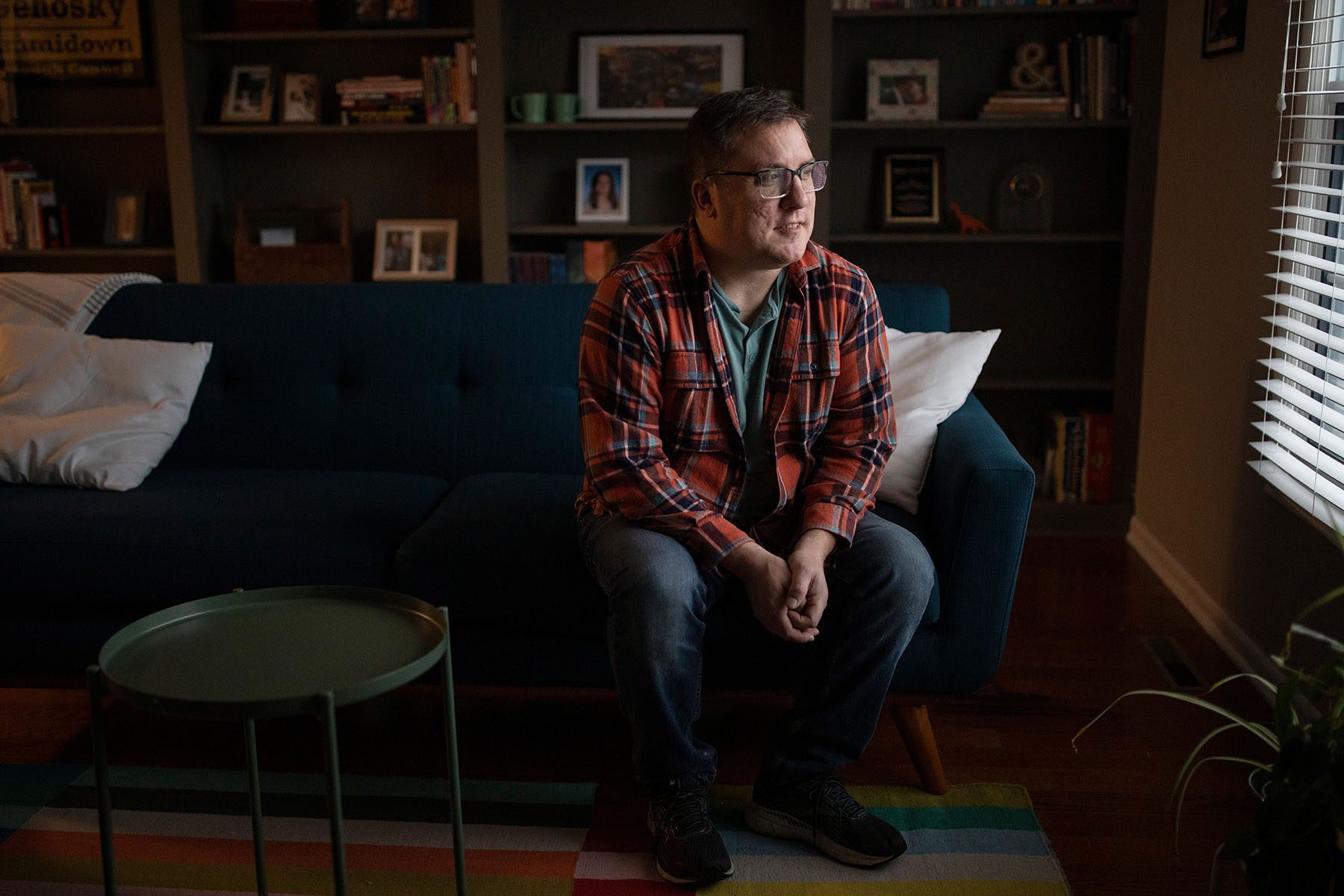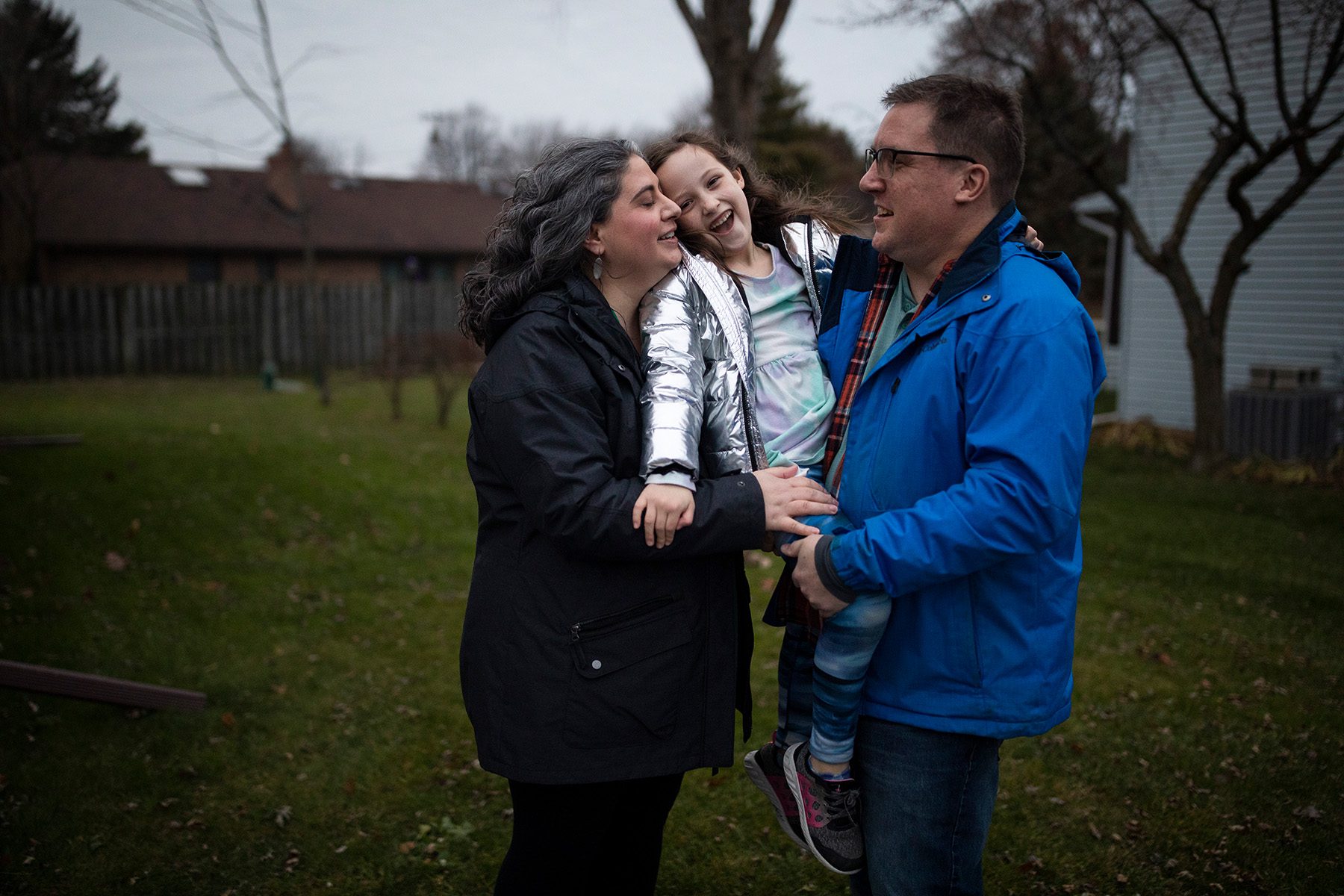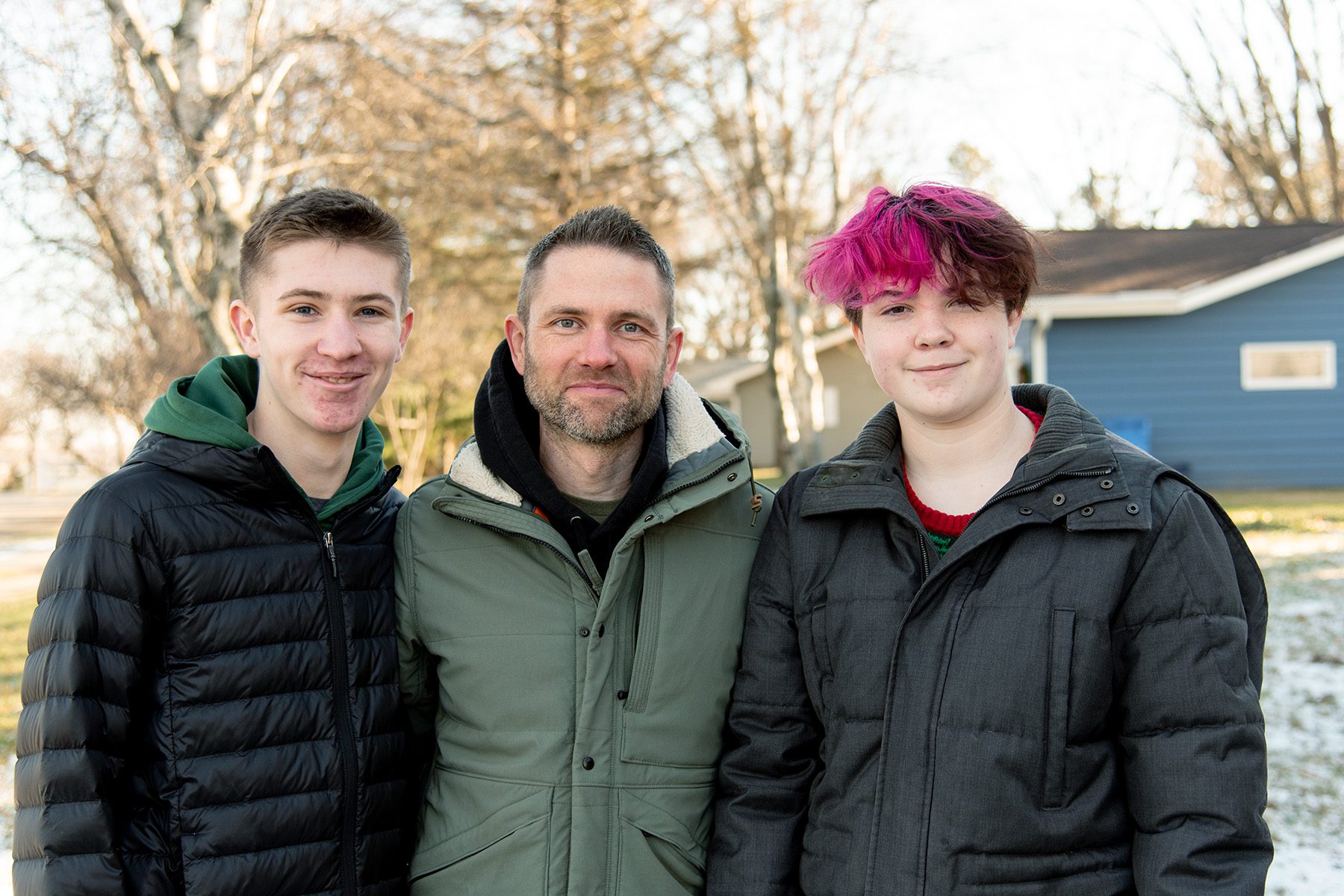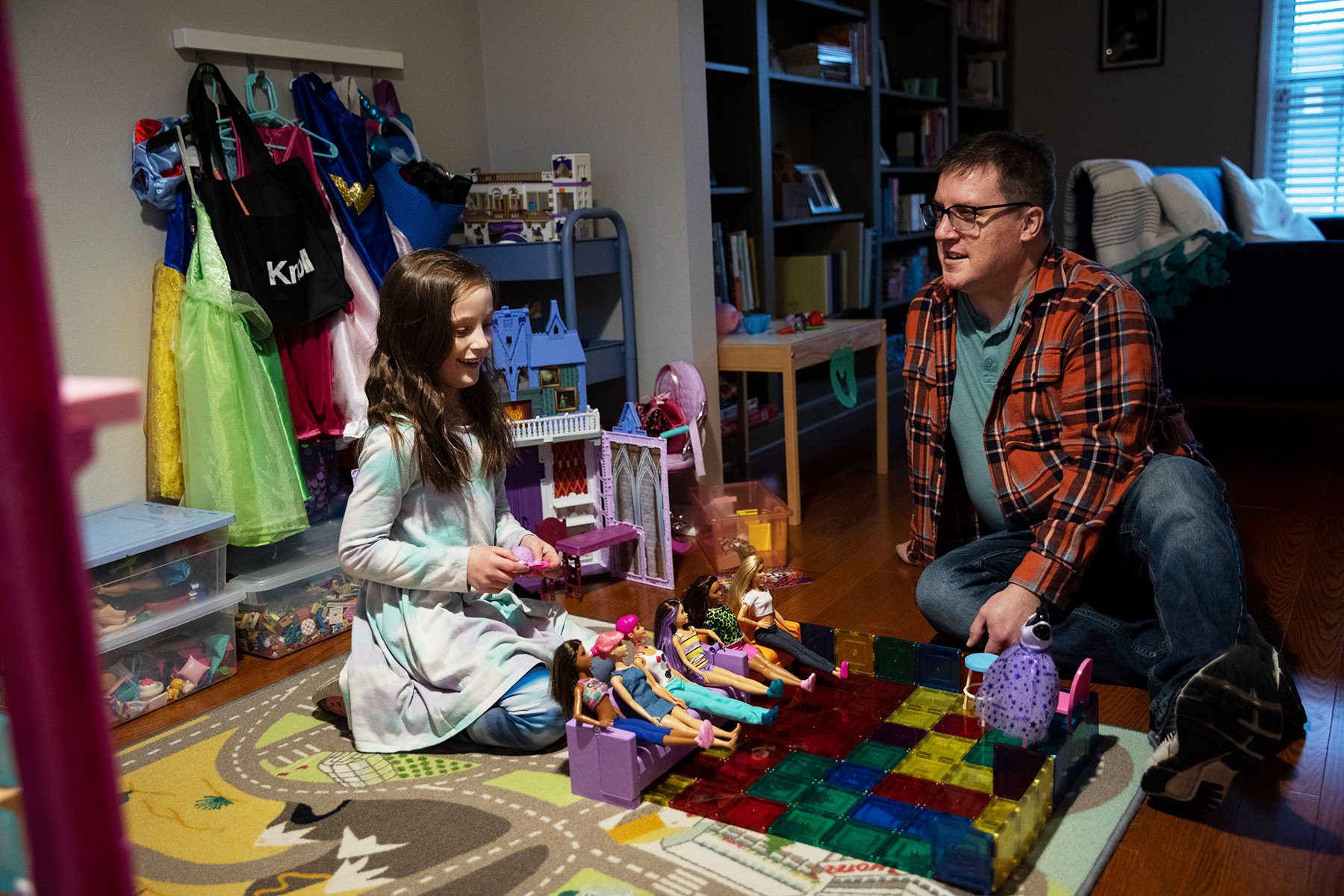Steve Ammidown and his wife had spent months juggling the relentless demands of child care and working from home during the pandemic. They took turns caring for their daughter and squeezing in a few hours of work before crashing into bed at night, drained and discouraged.
In the fall of 2020, Ammidown’s boss started to call with more frequency.
When, exactly, will you be back in the office full time?
The chair of the department is asking about you.
Things were nowhere near back to normal, but there was an unspoken expectation that he should figure it out anyway. Kids shouldn’t interrupt Zooms. Parents should start to return to the office.
Just a few years prior, Ammidown and his family had moved to Ohio for his dream job as an archivist at Bowling Green State University. But something had flipped for Ammidown in the months since the pandemic started. This time he had spent with his then-5-year-old daughter while his wife also worked remotely had profoundly realigned his priorities. He was not ready to give up time with her, and, besides, he still didn’t have any care options.
Facing intense pressure to return in person in December of last year, Ammidown realized his job was requiring something of him that he was no longer willing to compromise on: his health and his time with his family.
So he quit.

“I loved the work that I was doing, but the job wasn’t that important in the end,” said Ammidown, 47. “Over the last year, there’s been a lot of mental shifts of, ‘Maybe I’d be OK if I took a part-time job somewhere because that would let me do more of this care work.’ I’ve started to change the way I’m thinking about careers and jobs.”
That shift has happened in many American families, in some cases tearing down and rebuilding the constructs by which we decide who does what.
In most households where child care fell apart, it was mothers who were making the choice to quit work to care for children. The disintegration of care has pushed enough women out of work in the past two years to trigger a recession. What happened to moms was stark: Millions left the workforce, then hundreds of thousands more dropped out as the 2020 and 2021 school years began.
But what was happening to dads was less clear and, in some ways, more complicated.
As of October, about a million fewer fathers of school-age children were actively working in the labor force than pre-pandemic, compared with 1.4 million fewer moms of kids under the age of 18. In October, about half a million dads between the ages of 25 and 54 were on leave from work and another half a million were unemployed, according to data provided to The 19th by Misty Heggeness, a principal economist and senior adviser at the U.S. Census Bureau who has been closely tracking outcomes for mothers and fathers during the pandemic. (The available data does not reflect nonbinary people, but includes some LGBTQ+ parents.)
Those figures are all higher than pre-pandemic levels, but still largely trending downward month-to-month since early 2020.
What the data doesn’t reflect are all the decisions taking place individually, between partners and between colleagues — the places where gender norms that were once strictly followed, consciously or not, are becoming more fluid.
Ammidown’s model of a father, his own, worked the same job for about 40 years, always leaving at the same time in the morning and returning at the same time at night. In the year since he quit his job, Ammidown struggled with the expectation that he, too, should be employed.
Though he started to apply to jobs more seriously this fall, nothing has come together just yet. His daughter returned to school in-person in March.
“My kid is in school from 9 to 3 and I’ve had no problem filling the hours in between with cleaning and doing stuff around the house and projects. At the same time there is not the plethora of after-school care options that there were in the before times,” he said. “What would that look like if I went back to work?”

For decades in the United States, workers have had to adjust to the demands of their work, but what happens when work starts to come second for dads, the group of people who have been most expected to put it first?
Dominic Apugliese, a systems engineer on Florida’s Space Coast, is considering leaving his job and looking for another if his current employer forces him to return to work in person. Apugliese became a father during the pandemic — his daughter was born in February 2020 — and he’s only known a time when he’s been able to be home with her.
It’s helped him see, from the earliest days of his daughter’s life, the amount of work that has gone into her care between him and his wife. Studies have found that dads who take leave when their children are born are more likely to stay involved in their care long-term.
For Apugliese, it wasn’t leave, it was the pandemic.
“There might be a whole generation of dads that truly appreciate all those stay-at-home moms,” said Apugliese, 27.
For John Kuehl, that fuller appreciation, the kind that can only come from experiencing something yourself, has come later in life. In the past two years, roles have completely switched in his home.
Kuehl works for a food delivery tech company in Madison, Wisconsin, a job that had him in the office every weekday before the pandemic. His wife was a stay-at-home mom for many years, but recently, she became a special education case manager at a local high school. Now she’s out of the house most days, and he’s working remotely and caring for their 15-year-old and 13-year-old.
In 2020, Kuehl started taking on all the household work, the little things like remembering to put softener salt in the water softener, or cooking dinner, picking up the kids and walking the dog — even when he turned his ankle playing basketball.
Many of those were things, Kuehl felt, that everyone else barely even acknowledged.
This created some tension in the house, but Kuehl, 42, has started to wonder how much of it was self-created “for expecting some level of gratitude that it may not be fair to expect.” After all, he and his wife had been intentional about how they were going to make it work.
Should he “expect someone to thank me for doing something they don’t care about being done?” Kuehl said.
The pandemic, in a way, has made it harder to think like that.
“When everyone is fighting new personal battles that are different and probably more intense than normal, it seems like we all have less capacity than ever for seeing the struggle that others are going through,” Kuehl said. “When we yearn to be seen for what we are doing right now — by our employers, by our partners, even by our own kids — and would benefit maybe the most from it, we’re probably less likely than ever to have that need fulfilled.”
Dads don’t often take on that invisible labor — it’s work that is historically gendered — but mothers can recognize it even before you start to list examples. They know what it’s like to get no thanks for the cleaning and the laundry and scheduling the doctor’s appointments and remembering when they are out of cereal or when they need to buy a birthday gift. Some dads like Kuehl are experiencing that stress for the first time, and with it the complicated web of self-questioning about how much they should expect from their partners and how much they take on because they feel it’s work that needs to get done.

“I have to realize I’m doing that for me, and that is a healthier mindset for me than, ‘Oh my God, look at me slaving, how can no one acknowledge [it]’” he said.
Still, while dads have taken on more labor at home, a body of research indicates there are many ways the pandemic has pushed some families toward more traditional roles instead. William Scarborough, an assistant professor of sociology at the University of North Texas who has studied gender norms during the pandemic, said overall, it appears the pandemic could result in women taking on more work at home and with kids.
Early in the pandemic, studies found that mothers were reducing their work hours four to five times more than fathers in heterosexual couples where both parents were working. Another study of census data found that early on, both parents were experiencing similar work-related stress but that as time went on, fathers remained employed while moms have become more likely to reduce their hours, take leave or exit the labor force.
Intense expectations around worker productivity — the concept of the “ideal worker” who is fully committed to the job with no child care responsibilities — have pulled more people, and men in particular, back into the labor force as businesses have resumed work in person, Scarborough said. Layered on top is the idea that many households still “endorse a belief of gender essentialism,” he said, the belief that men and women have inherently different skill sets, with women being better equipped to handle care.
“It creates this feedback loop where mom is spending more time with the kids, so, practice makes perfect, she becomes even better at it. Dad, who’s now spending less time with the kids, has this learned helplessness,” Scarborough said. “Even if couples don’t endorse traditional norms, even if they are egalitarian, there are structures that force them to fill out their lives in a very traditional way.”
But that could be changing: For the first time, a proposal to infuse billions of dollars into child care, universal pre-K and paid leave could pass Congress, a reflection, Scarborough said, of a nation whose values might be changing. And when The 19th put out a call-out to dads for this story, the messages flooded in the first day. And the second. And the third. Dads, it seemed, were eager to talk about how the pandemic changed how they looked at parenting.
For Max Weisman, a communications professional in Philadelphia, it dredged up a deeper conversation about why we treat mothers and fathers differently.
Weisman has been working from home during the pandemic while his wife, a nurse, works out of the house three days a week. When he’s seen walking his toddler daughter in their neighborhood, he might have “10 people compliment how I’m our next savior, where my wife is never treated that way.”
In their neighborhood, he is known as “Sadye’s father.”
“It makes me sound like that superhero parent. But I do it three days a week and my wife does it three days a week, but she is not ‘Sadye’s mother,’” said Weisman, 30. “We put dads on this pedestal when we do half the work that moms do.”
Even still, the pandemic has created an opening for more understanding. Each parent understands the other’s job better now after being home together most days for the better part of two years.
“The appreciation for each other’s work gave us more empathy and giving each other time off and more willingness to take on those household tasks,” Weisman said.
It’s the power of visibility, said Jeremy Smith, the co-founder of the Mindful Return Working Dad Course, an employer-sponsored four-week online class that helps fathers adjust to their roles as working parents. The discussions dads have been having in the course this year are vastly different, he said.
“Historically, the role of dads has been quite different from what it is now, even though the realities have changed, I don’t know that the [national] discussion had changed on pace with it,” Smith said. “Just normalizing the fact that you’re allowed to have these opinions and to feel this way and that you’re not isolated or alone in that is sort of helping to bubble up change.”
Smith has seen how long it’s taken for those ideas to take hold. When he was working for a large finance company in 2014, he took parental leave for the birth of his first child. He said to his knowledge, he was the first person in his region to do that. The pushback wasn’t explicit, but it was there.
“It was more the undertone: ‘Well, what’s going to happen when you come back? Will it affect your bonus?” he said. It did affect his bonus: At the end of the year, his bosses said they found it was hard to make the case that he was an “exceeding performer” if he had been out for a third of the year.
So much of the focus is on productivity, he said — how can we squeeze the most out of everything? But Smith argues that things like parental leave should be included in conversations around how the benefits workers are given contribute to their “total return.” How does something like paid leave allow workers to lead fuller lives, which then makes them happier, more productive and less burned out?
“We don’t think about the long-term repercussions, we don’t price that in. No one values that in a dollar sense and adds it to a spreadsheet,” Smith said. “It’s only seen as a negative not a positive and, candidly, I doubt it’ll ever really change until we start to do that.”
There is still a long way to go. And things like parental leave are the first step in a change that happens not just in individual households, but systemically. If employers are not on board, if there is no mechanism to support people in their decisions, norms will stay where they are.
It’s only in the past several years as men have become more vocal about the need for paternity leave that the issue has risen in prominence. A decade ago, only 1 in 20 fathers surveyed by the Boston College Center for Work and Family were taking more than two weeks off for the birth of their child. When the study, which surveyed fathers in four Fortune 500 companies, was repeated last year, about 62 percent said they were taking the full leave available to them — six to 16 weeks.
But even large companies have rules about how and when parents can access leave. And sometimes, a parent’s intention is not enough.

Rob Hinton, who works for a large payment processing company out of Nebraska, was three weeks short of his one-year anniversary with the company when his child was born in November. Because of those three weeks, he did not qualify for the three months of fully paid leave his job offers to employees after one year. Instead he gets nothing.
Hinton, 36, has been trying to ask his company to give him the leave anyway, but there is no appeal process.
“I’ve had multiple HR people say like, ‘Well she had the kid right? It’s not an adoption or anything? If you had the kid you’d be able to, but it’s her medical condition,’” Hinton said. “It’s shocking, I didn’t realize how bad it was for dads until I became a dad.”
It feels almost like the cards are stacked against him, even when he wants to try. Hinton did not have a close relationship with his father, and promised himself he’d do it differently if he had children.
Being home throughout the pandemic while his wife was pregnant only reinforced that for him.
“I’m doing literally everything I can think of — I want to be as involved as possible,” he said. “It’s all shared, but it needs to be, at minimum, equal.”










